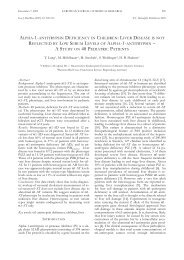European Journal of Medical Research - Deutsche AIDS ...
European Journal of Medical Research - Deutsche AIDS ...
European Journal of Medical Research - Deutsche AIDS ...
Create successful ePaper yourself
Turn your PDF publications into a flip-book with our unique Google optimized e-Paper software.
92 EUROPEAN JOURNAL OF MEDICAL RESEARCH<br />
June 27, 2007<br />
Conclusions: Results support switching from a stable CBVcontaining<br />
HAART to a completely qd regimen <strong>of</strong> TVD plus<br />
third divergent partner given that virologic (< 50 c/mL) and<br />
immunologic control were maintained with the additional<br />
benefit <strong>of</strong> Hb increasing significantly.<br />
D.34 (Poster)<br />
Successful salvage therapy with Darunavir and<br />
TMC-125 in a patient with a four-class drug<br />
resistant Tipranavir-experienced HIV-1 strain<br />
Harrer E. 1 , Müller S.M. 1 , Korn K. 2 , Walter H. 2 ,<br />
Schmidt B. 2 , Harrer T. 1<br />
1 Universitätsklinikum Erlangen, Medizinische Klinik 3,<br />
Klinische Infektionsimmunologie, Erlangen, Germany,<br />
2 Universitätsklinikum Erlangen, Institut für Klinische und<br />
Molekulare Virologie, Erlangen, Germany<br />
Introduction: Multiresistant HIV-1-infected patients failing<br />
therapy with tipranavir and T20 have only limited treatment<br />
options. TMC-125 and darunavir are newly introduced antiretroviral<br />
drugs with potent activity against resistant HIV-1-<br />
variants. Here, we report on the successful salvage therapy in<br />
a multiresistant patient using TMC-125 and darunavir.<br />
Methods: The then 34-year old patient was diagnosed with<br />
HIV-1-infection in 1993 when he presented with herpes zoster<br />
and a CD4 count <strong>of</strong> 120/l. Since 5/1993 he was treated with<br />
all available antiretroviral drugs: AZT, AZT+DDC,<br />
AZT+DDI, then 3-5 drug combinations including D4T, 3TC,<br />
DDI, ABC, TDF, loviride, EFV, HU, RTV, SQV, NLV, IDV,<br />
APV, LPV, TPV, alpha-IFN, T20. Most newly started therapies<br />
could induce a transient rise <strong>of</strong> CD4-counts and a reduction<br />
<strong>of</strong> HIV-1 viremia, but viral load could never be suppressed<br />
below the limit <strong>of</strong> detection. In July 2006 he showed a<br />
high viral load on treatment with AZT, 3TC, TDF and<br />
tipranavir/r. Genotypic resistance analysis showed resistance<br />
to all drugs <strong>of</strong> the current and preceding antiretroviral regimens<br />
with following mutations: NRTI: M 41 L, E 44 A, D 67<br />
N, L 74 I, V 75 M, F 77 L, V 118 I, M 184 V, H 208 Y, L 210<br />
W, R 211 K, T 215 Y, K 219 N; NNRTI: K103N; PI: L 10 I, I<br />
13 V, K 20 R, L 33 F, M 36 I, I 54 V, L 63 P, A 71 V, V 82 T,<br />
I 84 V, L 90 M. gp41 was not analysed, but T20 resistance<br />
had been documented two years ago.<br />
Results: In August 2006, as his viral load increased to 170<br />
000 and his CD4-count fell to 45/l, tipranavir/r was exchanged<br />
by a combination <strong>of</strong> darunavir/r and TMC-125.<br />
AZT,3TC and ten<strong>of</strong>ovir were continued and, in addition, T20<br />
was reinitiated, but was stopped after 4 days due to strong local<br />
injection site reactions. For the first time in the patient´s<br />
treatment history, this combination could decrease viral load<br />
below 50 copies/ml. 6 months after switching therapy his viral<br />
load is still suppressed and his CD4 count increased to<br />
226/l.<br />
Conclusion: This case demonstrates that the combination <strong>of</strong><br />
darunavir/r and TMC-125 can exert a potent antiretroviral effect<br />
even on highly resistant HIV-1 variants. Due to different<br />
patterns <strong>of</strong> resistance mutations darunavir/r may retain activity<br />
against tipranavir resistant HIV-1 strains.<br />
D.35 (Poster)<br />
Behandlung von Patienten mit Darunavir im<br />
klinischen Alltag – Woche 12 Ergebnisse<br />
Therapieverlauf, Vorhersagbarkeit des<br />
Therapieansprechens mithilfe verschiedener<br />
Resistenzalgorhythmen<br />
Baumgarten A. 1 , Berg T. 2 , Dupke S. 1 , Carganico A. 1<br />
1 Gemeinschaftspraxis Dupke/Carganico/Baumgarten, HIV-<br />
Schwerpunktpraxis, Berlin, Germany, 2 Labor Berg, Berlin,<br />
Berlin, Germany<br />
Ziel: Behandlung von 19 Patienten mit einer chronischen<br />
HIV-Infektion im Rahmen einer antiviralen Therapie mit<br />
DRV im Rahmen von Studien in unserer HIV-Schwerpunktpraxis.<br />
Es handelte sich um intensiv vorbehandelte Patienten<br />
mit multiplen Resistenzen. Die Umstellung erfolgte aufgrund<br />
von virologischen Versagen der Vortherapien bei Multiresistenzen.<br />
Methoden: Die Umstellungen erfolgten resistenzgesteuert auf<br />
ein DRV-haltiges Regime mit begleitendem optimalen Backbone.<br />
Als OBR wurde bevorzugt TZV und TDF (58%) eingesetzt.<br />
32% der Patienten (n=6) erhielten zusätzlich ENV.<br />
Ergebnisse nach Woche 12: Eine VL-Reduktion von 1log<br />
Stufe gelang bei 95% der Pat. (n=18), eine Reduktion um 2log<br />
Stufen bei 84% (n=16). 58% der Pat. (n=11) hatten nach drei<br />
Monate eine Viruslast von





